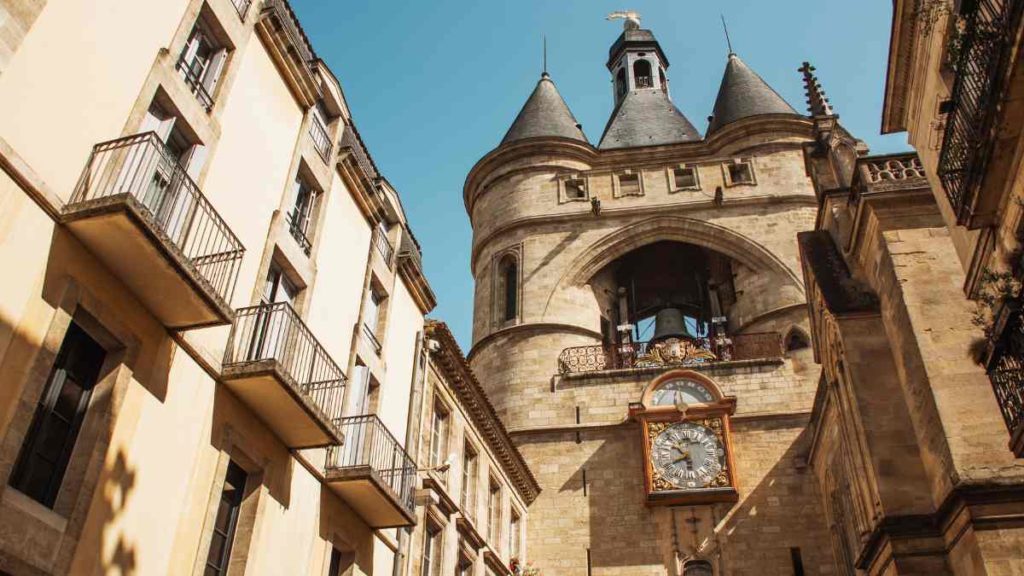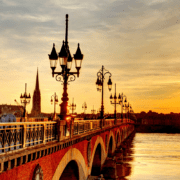
“Grosse Cloche”, the great bell of Bordeaux
The Great Bell of Bordeaux (or Grosse Cloche in French) is considered to be one of the most important and most photographed landmarks in Bordeaux. It is also one of the oldest monuments in the city, as its origins date back several centuries.
Read on to find out all you need to know about Bordeaux’s Great Bell Gate. We also invite you to discover other fascinating corners of the city with our free tour of Bordeaux, a fun and eco-friendly way to learn about Bordeaux’s culture and history.
History of the Grosse Cloche
The Great Bell of Bordeaux has its origins in the Middle Ages, when its base was built in the 13th century as part of the city’s defensive walls. At that time, Bordeaux was fortified like many other European cities, and the six gates of Bordeaux including:
The Great Bell was one of the busiest entrances, especially for pilgrims on their way to Santiago de Compostela.
It originally had six towers, although only two remain today. These are connected to each other by the central building. They are circular in shape, with conical ends, and each one is 40 metres high.
This gate was the official bell tower of the Town Hall, and was used to notify events such as grape harvests and fires. As a curious fact, you should know that the bell has been replaced at least six times, as they broke.
The current one was installed in 1775 by the founder Jean-Jacques Turmel. It weighs approximately 7,750 kilos, is two metres high and two metres in diameter at the bottom and one metre at the top. It is known as Armande Louis.
The building is crowned by a beautiful golden copper weathervane representing the English leopard. According to the locals, this was a kind of inheritance or gift that the city received during the period of English rule in France.
In 1759 a clock was installed above the gate, which still works today. It was an innovation for the time, as it allowed the citizens to see the time in a place other than the church bell tower.
From prison to historical monument
What few people know is that this building was also used as a prison in the past. Young people who caused trouble or misbehaved were locked up there. In fact, you can still see some of the cells with doors about 10 centimetres thick and huge locks.
In 1886 it was declared a Historical Monument.
Over the years, it has undergone several modifications and restorations, the last one in 2016. Even with so many centuries of history, behind its walls you can still breathe history, as in a way it allows you to take a journey through the past and discover fascinating curiosities of Bordeaux.
Bordeaux’s Saint Eloy Gate: the former name of the Great Bell of Bordeaux
In the past, the emblematic Grosse Cloche was known as the Porte Saint Eloy de Bordeaux. This name originated from the local devotion to Saint Eloy, the patron saint of goldsmiths and metalworkers, whose presence was notable around the gate.
Saint Eloy: goldsmith, bishop and patron saint of metalworkers
Saint Eloy, also known as Saint Eligius, was a prominent 7th-century French goldsmith and bishop. His skill in metalworking and his dedication to the Church earned him recognition as the patron saint of metalworkers. The naming of the gate as “Saint Eloy’s Gate” was a tribute to this saint and to the important craft activity that took place in the area.
From St. Eloy’s Gate to the Grosse Cloche
With the passing of the centuries and the growing prominence of the great bell that housed the building, the name gradually evolved to the current “Gate of the Great Bell” or “Grosse Cloche“. However, the memory of its former name, the Porte de Saint-Eloi de Bordeaux, remains as a testimony to the close link between the city and its religious and craft heritage.
Discovering the history behind the names of the monuments is one of the most enriching experiences of a stroll through Bordeaux’s old town. Every corner of the city holds secrets and anecdotes that take us back in time and reveal the profound identity of this French enclave.
The Gate of the Great Bell of Bordeaux: a timeless symbol of the city
Bordeaux’s Porte de la Grande Campane is a Gothic-style construction consisting of two octagonal towers linked by a central arch. Above the arch, one can see the city’s coat of arms, which depicts a red lion rampant on a white background.
The sundials and their philosophy
At the top of the towers are two sundials, which indicate the time according to the position of the sun. One of them has an inscription in Latin that reads: “Horas non numero nisi serenas”, which means “I do not count the hours but the serene ones”. This phrase expresses the philosophy of life of the brothel keepers, who prefer to enjoy the happy moments and forget the problems.
Delving into history: guided tours
Visitors have the opportunity to go inside the Porte de la Grande Campane de Bordeaux, where they can admire the structure of the bell and its ingenious mechanism. In addition, the more adventurous can climb up to the terrace and enjoy a panoramic view over the whole city, including other emblematic monuments such as the Porte de Bourgogne and the Porte Dijeaux. Although the visit is free of charge, it is necessary to book in advance at the tourist office.
The sound of the Grosse Cloche de Bordeaux: a special event
To speak of the Grosse Cloche de Bordeaux is to take a journey through its incredible history. In addition to the fact that it is located in the heart of the city, its sound has marked the most important moments that have taken place here since the 13th century.
Today, it still plays, only much less frequently. To be precise, it is played on the first Sunday of every month, at 12 noon. It is also played six more times throughout the year, on the days of great celebrations:
- 1 January
- 1st May
- 8th May
- 14th July
- 28th August
- 11th November.
The sound of the bell echoes through the streets of the old town, creating a magical and evocative atmosphere. It is a moment of celebration and connection with the history of the city, paying homage to Bordeaux’s traditions and cultural heritage.
Witnessing the tolling of the Grosse Cloche is a unique experience that will transport you back in time and make you feel part of the rich history of this French city. Don’t miss the opportunity to experience this special moment if it coincides with your visit to Bordeaux.
Privileged location in the old town
This architectural jewel is located in the heart of Bordeaux’s old town, a UNESCO World Heritage Site. Nestled in the bustling Rue Saint-James, one of the most lively and commercial arteries of the city, the door is surrounded by shops, bars, restaurants and art galleries.
It is also in the immediate vicinity of other historic buildings, such as the City Hall, Saint-André Cathedral and the Palais Rohan, as well as other important monuments of Bordeaux, such as the Grand Théâtre, the Place de la Bourse and the Mirror of Water.
A witness to Bordeaux’s history
Bordeaux’s Great Bell Gate is a living testimony to Bordeaux’s long history, dating back more than 2,000 years, when the Romans founded the city under the name of Burdigala.
- During the Middle Ages, Bordeaux emerged as a thriving commercial and cultural centre, maintaining close ties with England.
- In the 18th century, the city reached its peak thanks to the flourishing wine and sugar trade, which led to the embellishment of the city with neoclassical buildings and elegant squares that shaped its current appearance.
- The 19th century brought the industrialisation and expansion of Bordeaux, with the construction of new bridges and neighbourhoods.
Despite the ravages of the two world wars and the economic crisis of the 20th century, Bordeaux has undergone a profound transformation in recent decades, becoming a modern, dynamic and ecologically committed city that respects its rich heritage and unique identity.
Opening and prices of the Grand Belfry of Bordeaux
The Bordeaux Tourist Office is in charge of the administration of the site. Here you can enjoy one of the best panoramic views of the whole city thanks to its height. Its views combine the quays, the river and the neighbouring rooftops.
Apart from the former prison, you can also see the old gears and mechanisms during your visit to the Grosse Cloche. Here you can also see some tools and utensils from different periods that were used for the daily tasks in the building.
It is open to the public every day, with the exception of 25 December and 1 January. Depending on the time of year, the opening hours vary slightly:
- From October to May, from 2pm to 5pm.
- From June to September, from 1pm to 7pm.
The entrance fee is €5 per person.
How to get to the Great Bell of Bordeaux?
Like many of Bordeaux’s major monuments, the Grosse Cloche is located in the heart of the city centre. It’s not difficult to get to, and it’s not far at all. It is at 45 Rue de Saint-James, at the crossroads between Rue de Saint James and Rue de Guienne.
Discover the Great Bell of Bordeaux on a Free Tour
There is no better way to get to know a new city than by exploring its streets and sharing a little with the locals, and Bordeaux is no exception. On the contrary, here you have the advantage of being able to take a free tour, adapted to your interests and above all, to your language.
Free Walking Tours Bordeaux has all kinds of guided tours, both free and private for you to choose from.
They are guided by locals. This, among many other advantages, gives you the chance to learn more about the history. You will learn the anecdotes and some secrets related to the Great Bell of Bordeaux.



